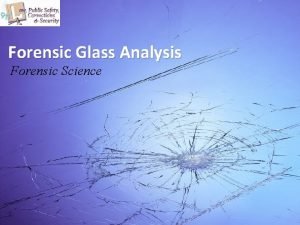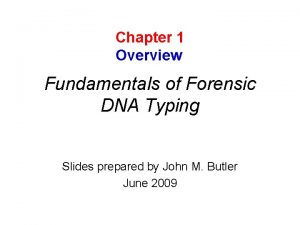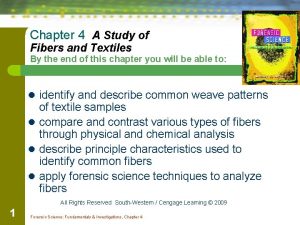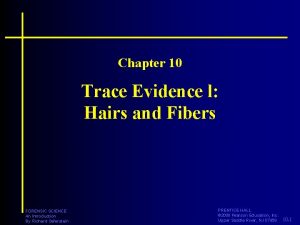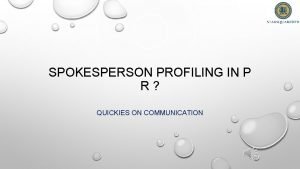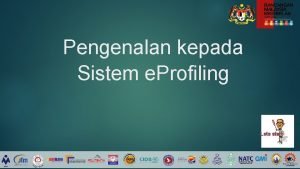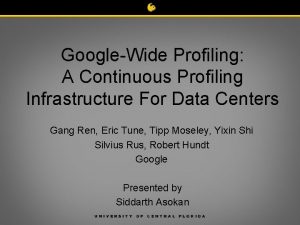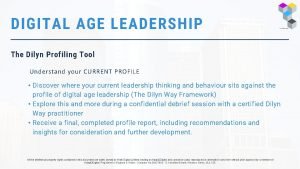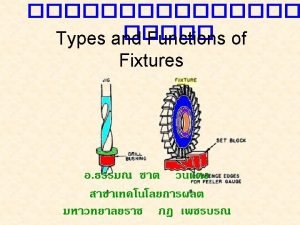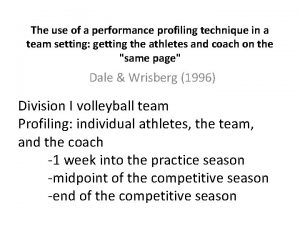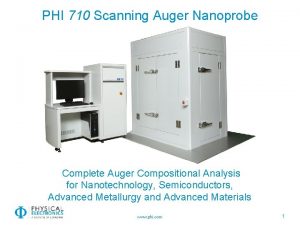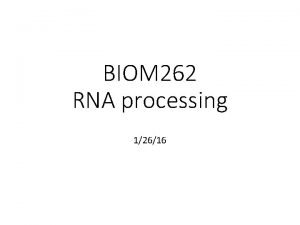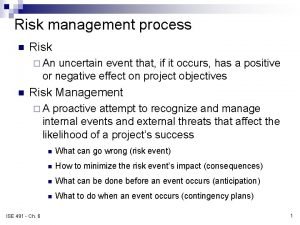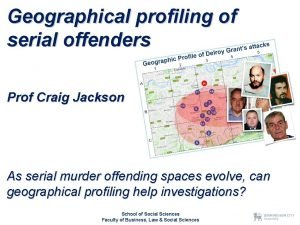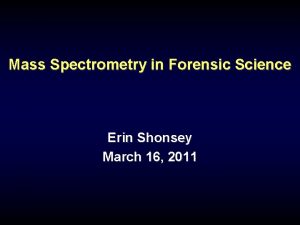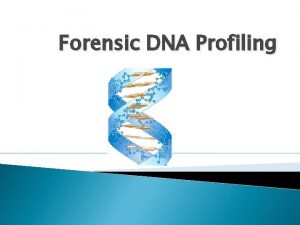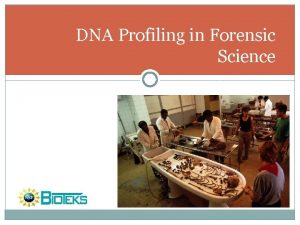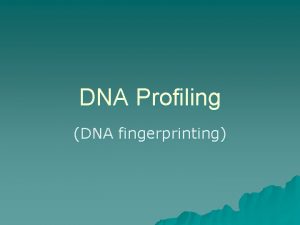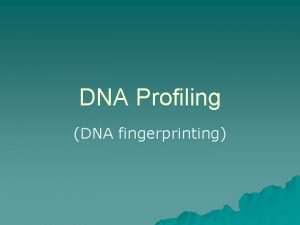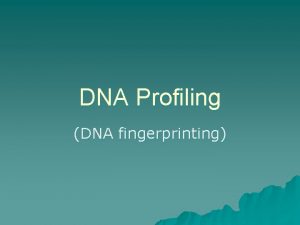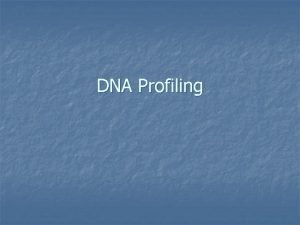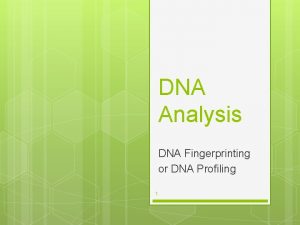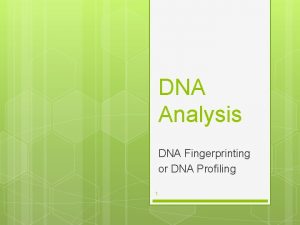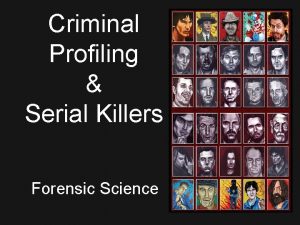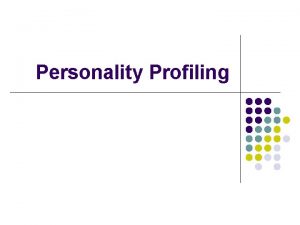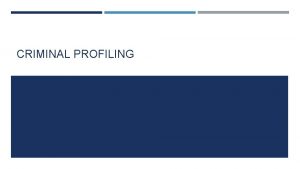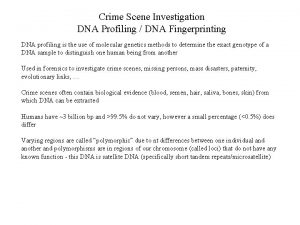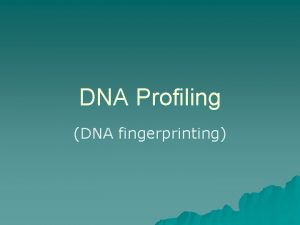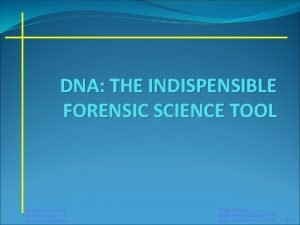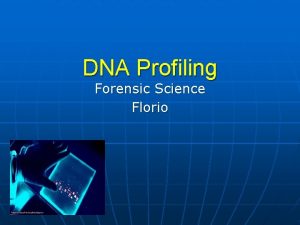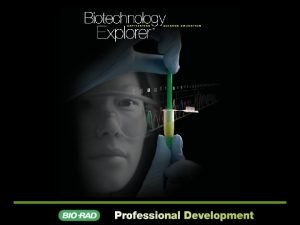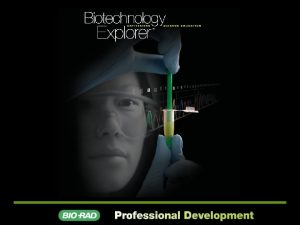DNA Profiling and Forensic Analysis Forensic science is















































- Slides: 47

DNA Profiling and Forensic Analysis

• Forensic science is the application of science to law –previous technologies used • photography, video cameras • fingerprinting –new technologies • DNA profiling

What is a DNA profile? • Every cell of an individual carries a copy of the DNA – a cell collected from a person’s skin or hair folicle contains the same DNA as from that persons heart tissue or white blood cells • Order of base pairs in the DNA of every individual is different except identical twins

How do we distinguish one person’s DNA from another? • We do not need to sequence the entire 3 billion base pairs of a person’s DNA to distinguish it from another person’s DNA • Intron regions of DNA contain sequences that are 20 -100 bp in length that are repeated at different locations (loci) along the chromosome. CGGCTACGGCTA (repeated 3 times at this location; at another location, it may be repeated 9 times) • These sequences are called Short Tandem Repeats (STRs) or VNTRs

STRs • Each person has some STRs that were inherited from mother and some from father • No person has STRs that are identical to those of either parent • The number of repeats at each loci on chromosome is highly variable in the population, ranging from 4 to 40.

• The uniqueness of an individual’s STRs provides a DNA profile. • The FBI has standardized a set of 13 STR assays (13 different locations on the chromosomes) • The United States maintains the largest DNA database in the world: The Combined DNA Index System

Preparation of a DNA profile Step 1 • Specimen collection – blood, semen, etc – easy to contaminate a DNA sample with DNA from other sources (bacteria, DNA of person collecting sample) – DNA is not stable for very long-it degrades • sunlight • heat • moisture

• DNA profiling is a comparative process: – DNA from crime scene is compared with DNA of a suspect – So minimum of two samples must be prepared Step 2 • DNA extraction – need to separate DNA from other cell material and debris from crime scene.

Step 3 PCR using primers targeting STRs at different loci • PCR amplify STRs using target sites on chromosome

Step 3 PCR amplification of DNA 1 strand of DNA Heat to denature doublestranded DNA Design primers that anneal to STR locus Amplify all the regions of the chromosome where the STRs exist. STR locus

PCR allows you to make millions of copies of the STR region from a single copy of DNA you recovered from crime scene.

• Since the # of times sequence is repeated is different for each person, fragment size will be different. • This is done for 13 different STR sequences at this one locus • Differences occur among individuals at each of the 13 loci on the chromosome where the STRs occur • This allows for a lot of variation

Restriction Fragment Length Polymorphism For 1 STR sequence at 1 locus Person A Forensic sample STR G-G-C-C-X-X-X-G-G-C-C-X-X. . G-G-G-C-C-X-X…. . PCR amplify STR region C-C-X-X-X-G-G well C-C-X-X-G-G well Gel electrophoresis

• If you do this for 13 different repeat sequences at 13 different loci on the chromosome, each person produces a different band pattern when the fragments are separated by gel electrophoresis

Different STRs at other loci STR 1 STR 2 STR 3 Do any of the individuals compare with forensic sample?

Other approaches to DNA profiling • Dot Blotting – Genes that display high sequence variability can be substituted for STRs – An example of a gene with this property is the human leukocyte antigen (HLA). – The gene encoding this protein has lots of sequence variability across the human population. – Since this gene is not present in other life forms, it reduces the interference that could otherwise be contributed by bacteria, fungi, dog, or cat DNA picked up in the sample at crime scene.

• Dot blotting (continued) – Because every gene amplified by PCR has the same length, we don’t need to use electrophoresis to sort and separate the fragments. – Instead, we use “blot strip” or dot blot which contains a different DNA probe that is sensitive to the sequence variability.

Dot Blot biotin C-G-T-A Probe made from sequence obtained from forensic sample G-C-A-T……. Single strand of HLA gene amplified DNA from sample

Binding of probe to complementary DNA biotin C-G-T-A G-C-A-T……. C-G-T-C Probe 3 Binding takes place No binding takes place

Wash away unreacted probe and add biotin-reactive enzyme Colorless substrate Strepavidin (colorless enzyme) Colored product (spot lights up) biotin C-G-T-A G-C-A-T…….

Dot Blot • A visual signal is produced when the different probes anneal (bind) to the complementary sequence in the DNA sample Crime scene PCR amplified DNA on each spot biotin C-G-T-A Probe 1 C-G-T-T Probe 2 C-G-T-C Probe 3

What do we end up with? • Blot strips show a pattern of spots that either light up or remain dark • Compare pattern produced from crime scene DNA to pattern produced from suspect DNA Scene DNA Suspect DNA

Types of Blot Tests

Characterization: Southern blot hybridization -transfer of DNA from a gel to a membrane (e. g. , nitrocellulose, nylon) -developed by Edwin Southern

Characterization: Northern blot hybridization X RNA X x salt X RNA -transfer of RNA from a gel to a membrane (e. g. , nitrocellulose, nylon) -reveals m. RNA size (and approximate protein size), tissue- and organspecific expression, and kinetic patterns of expression

Characterization: Western blotting X Protein X React with Antibody x Enzyme reaction or X Buffer; requires electric current X -transfer of protein from a gel to a membrane (e. g. , nitrocellulose, nylon) -requires the use of an electric current to facilitate transfer

Characterization: Eastern blotting -biochemical technique used to analyze protein post transitional modifications (PTM) such as lipids, phosphomoieties and glycoconjugates. It is most often used to detect carbohydrate epitopes -can be considered an extension of the biochemical technique of Western blotting

DNA profiling in practice • Rape cases often sample a victims vagina for sperm in order to get a profile of the rapist • Victims vaginal cells that are mixed in with rapist’s sperm cells make it difficult to get a profiling of the rapist’s DNA • Scientists studying sperm cells discovered that they resist lysis in certain solutions that induce lysis of vaginal cells. • They used this knowledge to separate DNA from sperm and vaginal cells

Transfer cells on swab to lysis buffer 1 Lysis buffer causes vagina cells to lyse and release DNA into solution Centrifuge tube to sediment sperm cells, then decant supernatant to remove vagina DNA Add lysis buffer 2 Lysis buffer causes remaining sperm cells to lyse and release DNA into solution

Always need suspect DNA • When suspect’s DNA doesn’t match sperm DNA from victim, investigation hits a barrier. • Need to find more suspects – Computer searchable DNA databases are now authorized by all 50 states – in some cases courts have agreed that collecting blood sample from someone without “probable cause” violates state and federal laws prohibiting unreasonable search and seizure. stopped

• Need lucky break or a lead that gets you to the perpetrator or the crime.

DNA profile database • CODIS: Combined DNA Index System – run by FBI – contains profiles of convicted offenders – contains unidentified DNA taken from crime scenes – visit CODIS website to see how it works • http: //www. fbi. gov/about-us/lab/biometricanalysis/codis – CODIS allows identifying possible suspects when no prior suspect exists

Invasion of privacy • Some groups are worried that DNA samples will get in hands of insurance companies or potential employers – use to identify genetic defects that might cost them $$ • Why is this concern invalid? – What do you need to identify a genetic defect? – What does the STR analysis yield in the way of data that can provide information on genetic disorders? • Some groups are demanding that DNA samples be destroyed after investigation is complete. – Is this a good idea?

• DNA profile can be used to refute erroneous evidence that would otherwise convict an innocent suspect • DNA evidence can expose a faulty eyewitness – Forest Hills Rapist • 3 separate victims identified assailant as Black to the police • Suspect on trial for crimes was White • DNA of white suspect was tested and matched DNA from sperm left at scene of each crime

Meeting Legal Standards • Court uses 5 different standards to determine whether evidence should be allowed in court • Any new technique must meet one or several of the standards before evidence using new technique can be introduced.

5 Standards • Relevancy test • Frye standard-general acceptance test • Coppolino standard - allows new or controversial science to be used if adequate foundation can be laid. Expert witnesses used in this case. • Marx standard - court must be able to understand evaluate scientific evidence. A university professor may be brought in to give a lecture of the concept. • Daubert standard - requires special pretrial hearings for scientific evidence. Scientific procedure must be described in a peer-reviewed journal

Simpson/Goldman Murder • Pretrial hearings announced that blood collected at crime scene matched that of O. J. s • Defense argued that contamination could have occurred during sample collection and between collection of different samples • Technician admitted mislabeling samples • Possibility that evidence might be tainted was obvious to both the court and the jury • DNA evidence was not allowed as evidence • When rules of evidence are not followed, DNA samples lose their value in court.

Chain of custody • Requires that collection of evidence must be systematically recorded and access to evidence must be controlled – Special challenges for DNA samples • crime scene may have DNA from people other than perpetrators of crime. These people could become suspects based on this DNA • DNA collected from victims in a morgue can become contaminated by DNA of other bodies previously on autopsy table • during early days all procedures for processing DNA was not standardized, people running assays were not experienced and made mistakes

Paternity testing • Verifying parents of a child to determine responsibility for child support • 250, 000 cases per year in U. S. • Using amniocentisis, it is even possible to verify a child’s parents before birth – collect fetal cells from amniotic fluid – DNA extraction and profiling.

PCR amplification, then DNA fingerprinting

Mother’s STRs of suspected Father Is the suspect the father? Offspring STRs

Tracing genealogy through mother’s mitochondrial DNA • Inside each cell of the body is an organelle called the mitochondria • The mitochondria has chromosomes that were only inherited from the mother (Mt. DNA) – comes from the cytoplasm of the egg. • The DNA of the mother’s mt. DNA is the same as her mother’s mt. DNA, and so on, back through the maternal bloodline.


• mt. DNA is used to reunite families separated by corrupt governments – Junta in Argentina arrested pregnant women and took their newborn infants and gave them to supporters of the regime without consent of mother. – AAAS helped reunite 51 children with their natural mothers after the Junta regime collapsed. • mt. DNA can be used to identify a buried corpse that has been buried for many years if you have living relatives whose DNA you can compare it to.

3 parent children

Mt. DNA and evolutionary biology • mt. DNA mutates at a relatively constant rate of 2 -4% every million years. – Allows scientists to trace gene frequency changes over time. – “Eve hypothesis” allowed scientists to trace a majority of people now living on Earth to a common female ancestor from ancient Africa – Followed human migration and dispersal from that location to other parts of the world. • Jared Diamond’s “Guns Germs and Steel”

Careers in DNA testing • Laboratory technicians – must be able to work very meticulously • forensic science technicians must pass a test to demonstrate these skills before being let loose at a crime scene • sometimes have to perform their sample manipulation in a “clean room” – Requirements • B. S. degree in biology, biochemistry or molecular biology or a specialized Associate’s degree in biotechnology and laboratory experience. • Good writing skills (lab notebook entries) • Good math and communication skills – Salaries $31 K to $45 K entry level depending on location.
 Fiber analysis forensic science
Fiber analysis forensic science What is glass analysis in forensic science
What is glass analysis in forensic science Radial lines glass
Radial lines glass Coding dna and non coding dna
Coding dna and non coding dna What is your favorite science subject
What is your favorite science subject Thomas mocker and thomas stewart
Thomas mocker and thomas stewart Forensic psychiatry vs forensic psychology
Forensic psychiatry vs forensic psychology Fundamentals of forensic dna typing
Fundamentals of forensic dna typing Function of dna polymerase 3
Function of dna polymerase 3 Bioflix activity dna replication nucleotide pairing
Bioflix activity dna replication nucleotide pairing What role does dna polymerase play in copying dna?
What role does dna polymerase play in copying dna? Dna and genes chapter 11
Dna and genes chapter 11 Forensic science fundamentals and investigations chapter 6
Forensic science fundamentals and investigations chapter 6 Fiber weave patterns forensics
Fiber weave patterns forensics Forensic science chapter 1
Forensic science chapter 1 Hairs and fibers in forensic science
Hairs and fibers in forensic science Activity profiling
Activity profiling Your limitations as a student
Your limitations as a student Spokesperson
Spokesperson Eprofiling
Eprofiling Typological profiling
Typological profiling Channel partner profiling
Channel partner profiling Google wide profiling
Google wide profiling Nilai jabatan adalah
Nilai jabatan adalah Leadership profiling tools
Leadership profiling tools Criminal profiling serial killers
Criminal profiling serial killers Gather approach of counselling
Gather approach of counselling Competency profiling software
Competency profiling software Hell ase
Hell ase Top-down vs bottom-up profiling
Top-down vs bottom-up profiling Top down profiling
Top down profiling Qnx cpu usage
Qnx cpu usage Brianmac scat test
Brianmac scat test Define and classify fixtures.
Define and classify fixtures. What is character profiling
What is character profiling Performance profiling techniques
Performance profiling techniques Column profiling
Column profiling Rna
Rna Farmer profiling
Farmer profiling Uncertain event
Uncertain event Skus
Skus Geographic profiling
Geographic profiling Lighthouse profiling
Lighthouse profiling Sola pith forensic
Sola pith forensic Morphology in forensics
Morphology in forensics Mass spectrometry in forensic science
Mass spectrometry in forensic science Forensic science branches
Forensic science branches How many people did aileen wuornos kill
How many people did aileen wuornos kill

